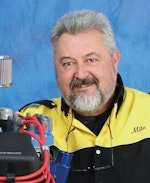Look around as you drive along your daily route. Chances are, you’ll notice a few late model vehicles that feature curiously small grille areas. You may wonder how the engine maintains proper temperature with such tiny air inlets.
As vehicle designers play with body shapes and continually attempt to conjure new and “exciting” exterior body designs while chasing the sometimes elusive gremlins of aerodynamics and coefficients of friction, they sometimes end up with air intakes that look as though they would challenge a mosquito for entry into the engine bay.
As a result of playing video games on their state-of-the-art design-department computers and testing prototype approaches in the lab and on their test tracks, they devise sometimes simple/sometimes complex systems of ducting, vents, under-radiator air deflectors, louvers and baffles that direct oncoming and undercar air into the engine compartment to a point where engine temperature is manageable.
The problem that you can face is a result of the real world, where consumers continue to bash into each other (we call them “accidents”), which sends the vehicle into the no-man’s-land where the vehicle is at the mercy of the often unholy alliance of insurance adjusters and collision shops. If the vehicle is repaired properly, there should be no further complications down the road. However, if an untrained body shop guy doesn’t recognize a “mysterious” baffle or vent piece, or assumes that “the little weird plastic thing” doesn’t look like it’s necessary, or if the insurance adjuster is dumb enough to disallow a new replacement, a crucial element of engine cooling may be dismissed and left out, or installed incorrectly where it can’t do its job.
Days or weeks after the vehicle is released from the body shop, the car may enter your shop with an overheating problem that can easily lead you down a dead-end path of time-wasting diagnosis.
If a customer presents an overheating issue, naturally you’ll first look at the basics (coolant level, coolant leaks, coolant in oil, hoses, water pump, trapped air, thermostat, etc.), but it’s in your best interest to first ask if the vehicle has been in an accident. Being aware of a crash history can provide valuable diagnostic background, especially for those late model vehicles that feature tiny and apparently restrictive air intakes.
If you’re unfamiliar with the specific year/make/model at hand, you might want to refer to a body service manual to identify critical airflow components. This will at the very least allow you to know if something is missing. ●
Hey, I want your email address
At times, it’s nice to be able to shoot a quick question to some of our readers. For example, “Are there any alignment shops in your area?” or “I’m thinking of writing an article on troubleshooting fuel problems on a Ford F-150... is this something you’d like to see?” or “Where’s the best rib joint in your town?” etc.
If you decide to provide it, send your email address to [email protected]. Be sure to include your name, the name of your shop and the town and state in the email message. Tell me what your shop specializes in, too.
That will allow me to contact you if I have a question that you might be able to answer, given your type of shop and the shop location.
There’s no guarantee that I will write you, but in those circumstances it would be nice to be able to directly communicate with a few experienced techs around the country.
I won’t provide your email address to anyone. It’s just so that I can send a message or question when it would be helpful. When you have a minute to spare, lay down your ratchet, wipe off your hands and type out a short message to me on your smartphone or PC. I look forward to hearing from you. – Mike



